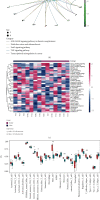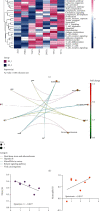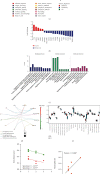Neoadjuvant Chemotherapy Improves the Immunosuppressive Microenvironment of Bladder Cancer and Increases the Sensitivity to Immune Checkpoint Blockade
- PMID: 35915657
- PMCID: PMC9338739
- DOI: 10.1155/2022/9962397
Neoadjuvant Chemotherapy Improves the Immunosuppressive Microenvironment of Bladder Cancer and Increases the Sensitivity to Immune Checkpoint Blockade
Abstract
Although tumor immune microenvironment plays an important role in antitumor therapy, few studies explored the gene signatures associated with the tumor immune microenvironment of bladder cancer after neoadjuvant chemotherapy. We examined and analyzed differentially expressed genes from 9 patients with stage I-III bladder cancer by RNA immune-oncology profiling platform. After neoadjuvant chemotherapy, the expressions of 43 genes in 19 pathways and 10 genes in 5 pathways were upregulated and downregulated, respectively. Neoadjuvant chemotherapy also promoted the expression of genes related to the activation of antitumor immune responses and decreased the expression of genes related to tumor proliferation pathways. In addition, neoadjuvant chemotherapy improved tumor response to immune checkpoint blockade. Furthermore, this study also identified several genes that can be used to predict the efficacy of neoadjuvant chemotherapy and their possible molecular mechanisms. In conclusion, neoadjuvant chemotherapy may promote the activation of antitumor effects, improve the suppressive tumor immune microenvironment, and increase the sensitivity of bladder cancer to immune checkpoint blockade.
Copyright © 2022 Hao Luo et al.
Conflict of interest statement
The authors declare that they have no competing interests.
Figures




Similar articles
-
Expression-based subtypes define pathologic response to neoadjuvant immune-checkpoint inhibitors in muscle-invasive bladder cancer.Nat Commun. 2023 Apr 27;14(1):2126. doi: 10.1038/s41467-023-37568-9. Nat Commun. 2023. PMID: 37105962 Free PMC article.
-
Rationale and Outcomes for Neoadjuvant Immunotherapy in Urothelial Carcinoma of the Bladder.Eur Urol Oncol. 2020 Dec;3(6):728-738. doi: 10.1016/j.euo.2020.06.009. Epub 2020 Nov 8. Eur Urol Oncol. 2020. PMID: 33177001
-
Genomic stratification based on microenvironment immune types and PD-L1 for tailoring therapeutic strategies in bladder cancer.BMC Cancer. 2021 May 31;21(1):646. doi: 10.1186/s12885-021-08350-1. BMC Cancer. 2021. PMID: 34059019 Free PMC article.
-
Integrating angiogenesis signature and tumor mutation burden for improved patient stratification in immune checkpoint blockade therapy for muscle-invasive bladder cancer.Urol Oncol. 2023 Oct;41(10):433.e9-433.e18. doi: 10.1016/j.urolonc.2023.07.006. Epub 2023 Aug 23. Urol Oncol. 2023. PMID: 37625906
-
Biomarkers of Immune Checkpoint Blockade Response in Triple-Negative Breast Cancer.Curr Treat Options Oncol. 2021 Mar 20;22(5):38. doi: 10.1007/s11864-021-00833-4. Curr Treat Options Oncol. 2021. PMID: 33743085 Review.
Cited by
-
Three versus four cycles of neoadjuvant chemotherapy for muscle-invasive bladder cancer: a systematic review and meta-analysis.Ann Med. 2023;55(2):2281654. doi: 10.1080/07853890.2023.2281654. Epub 2023 Nov 14. Ann Med. 2023. PMID: 37963224 Free PMC article.
-
Prediction of response to neoadjuvant chemotherapy in patients with muscle-invasive urothelial bladder cancer: role of immune-related gene expression.Cancer Immunol Immunother. 2025 Jul 30;74(9):279. doi: 10.1007/s00262-025-04135-8. Cancer Immunol Immunother. 2025. PMID: 40736702 Free PMC article.
-
Development and validation of machine learning-based diagnostic models using blood transcriptomics for early childhood diabetes prediction.Front Med (Lausanne). 2025 Jul 16;12:1636214. doi: 10.3389/fmed.2025.1636214. eCollection 2025. Front Med (Lausanne). 2025. PMID: 40740938 Free PMC article.
References
-
- Donat S. M., Shabsigh A., Savage C., et al. Potential impact of postoperative early complications on the timing of adjuvant chemotherapy in patients undergoing radical cystectomy: a high-volume tertiary cancer center experience. European Urology . 2009;55(1):177–186. doi: 10.1016/j.eururo.2008.07.018. - DOI - PubMed
-
- Griffiths G., Hall R., Sylvester R., Raghavan D., Parmar M. K. International phase III trial assessing neoadjuvant cisplatin, methotrexate, and vinblastine chemotherapy for muscle-invasive bladder cancer: long-term results of the BA06 30894 trial. Journal of Clinical Oncology . 2011;29(16):2171–2177. doi: 10.1200/JCO.2010.32.3139. - DOI - PMC - PubMed
MeSH terms
Substances
LinkOut - more resources
Full Text Sources
Medical

